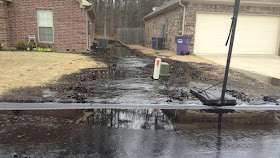PHMSA 20-16
Tuesday, August 16, 2016
Contact: Artealia Gilliard
Tel.: 202-366-4831
PHMSA Clarifies Regulatory Requirements Regarding Abandoned Pipelines
WASHINGTON - Today, the U.S. Department of Transportation's (DOT) Pipeline and Hazardous Materials Safety Administration (PHMSA) issued an advisory bulletin to clarify the regulatory requirements for classifying pipelines based on their operational status. The bulletin highlights procedures for changing the status of a pipeline facility from "active" to "abandoned" for owners and operators of gas and hazardous liquid pipeline facilities and federal and state pipeline safety personnel.
A 2014 pipeline failure that allowed 1,200 gallons of crude oil to seep into a residential neighborhood near Los Angeles raised concerns about the need to remind pipeline operators about the proper way to purge and clean inactive pipelines. This action makes it clear that federal regulations consider pipelines to be either active and fully subject to all parts of the safety regulations or abandoned.
PHMSA is aggressively working to implement the Protecting our Infrastructure of Pipelines and Enhancing Safety (PIPES) Act of 2016, which was enacted in June of this year. Today's notice fulfills a requirement from Section 23 of the PIPES Act that mandates DOT issue an advisory bulletin to the pipeline industry regarding procedures to change the status of a pipeline facility from active to abandoned.
To view the Federal Register notice, click here.
For more information on the U.S. DOT's efforts to improve pipeline and hazardous materials safety and awareness, including details about the advisory bulletin, visit the PHMSA website at www.phmsa.dot.gov.
============================

Pipe Subject to Safety Regulations Until Formally Abandoned: PHMSA Advisory
By Hunton & Williams LLP on August 23, 2016
PHMSA issued an advisory to operators regarding the applicability of its safety regulations to idled, inactive and abandoned pipe. Congress directed PHMSA to issue such an advisory in the recent PIPES Act of 2016, in response to several high profile incidents involving idled pipe. While operators frequently refer to idled, decommissioned, mothballed and/or inactive pipe, PHMSA does not recognize those terms.
In its advisory, the Agency explains that it considers pipelines to be either active and subject to all relevant safety regulations or abandoned (i.e. permanently removed from service). With respect to a pipeline that is “purged” of all combustibles but not yet formally abandoned, PHMSA confirms its current practice of accepting deferral of certain activities, including inline inspection, as long as deferred activities are completed prior to or as part of returning a pipeline to service. This is consistent with prior PHMSA guidance.
In addition, PHMSA reminds operators of the requirements for formally abandoning pipe (at Part 192.727 for gas pipelines and 195.402(c)(10) for oil pipelines), including affirmative notice to PHMSA for offshore facilities and onshore facilities that cross waterways. Notably, the Agency recognizes that some pipelines may have been abandoned prior to the effective date of the abandonment regulations and owners may not have records relating to the location of those pipelines or whether they were properly purged of combustibles and sealed.
PHMSA adds, however, that owners and operators have a “responsibility to assure facilities for which they are responsible or last owned do not present a hazard to people, property or the environment,” later adding “to the extent feasible.” Further, PHMSA notes that owners and operators are “fully responsible for the safety of their pipelines at all times and during all operational statuses.” The Agency also signals that it is considering proposing procedures in a future rulemaking for notifying regulators of purged but active pipelines.
In addition to regulatory obligations, the owner of an abandoned pipeline may have potential liability under common law for any nuisance or hazard that may be created by leaving pipe in the ground. These issues vary by state and each fact situation, and become more acute when water crossings are included.
In light of the above, owners and operators should ensure that they are aware of all potential issues and liabilities associated with proposals to abandon, purge or idle certain facilities and the possible acquisition of abandoned, purged, or idled pipeline facilities. Owners and operators should be prepared to demonstrate compliance with applicable laws and regulations for assets which they own or operate. In addition, the industry should anticipate future rulemakings that could require affirmative notice obligations for all abandoned pipelines as well as purged but active pipelines.

